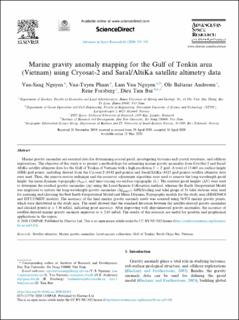| dc.contributor.author | Nguyen, Van-Sang | |
| dc.contributor.author | Pham, Van-Tuyen | |
| dc.contributor.author | Nguyen Van, Lam | |
| dc.contributor.author | Andersen, Ole Baltazar | |
| dc.contributor.author | Forsberg, Rene | |
| dc.contributor.author | Tien Bui, Dieu | |
| dc.date.accessioned | 2021-04-06T09:55:57Z | |
| dc.date.available | 2021-04-06T09:55:57Z | |
| dc.date.created | 2020-07-03T14:02:30Z | |
| dc.date.issued | 2020 | |
| dc.identifier.citation | Nguyen, V. S., Pham, V. T., Van Nguyen, L., Andersen, O. B., Forsberg, R., & Bui, D. T. (2020). Marine gravity anomaly mapping for the Gulf of Tonkin area (Vietnam) using Cryosat-2 and Saral/AltiKa satellite altimetry data. Advances in Space Research, 66(3). | en_US |
| dc.identifier.issn | 0273-1177 | |
| dc.identifier.uri | https://hdl.handle.net/11250/2736340 | |
| dc.description.abstract | Marine gravity anomalies are essential data for determining coastal geoid, investigating tectonics and crustal structures, and offshore explorations. The objective of this study is to present a methodology for estimating marine gravity anomalies from CryoSat-2 and Saral/AltiKa satellite altimeter data for the Gulf of Tonkin of Vietnam with a high-resolution 2′ × 2′ grid. A total of 15,665 sea surface height (SSH) grid points, including derived from the Cryosat-2 (6842 grid points) and Saral/AltiKa (8823 grid points) satellite altimeter data were used. Then, the remove-restore technique and the crossover adjustment algorithm were used to remove the long-wavelength geoid height, the mean dynamic topography , and time-varying sea-surface topography . The residual geoid heights were used to determine the residual gravity anomalies using the Least-Squares Collocation method, whereas the Earth Geopotential Model was employed to restore the long-wavelength gravity anomalies . GPS/leveling and tidal gauge of 31 tidal stations were used for assessing and choosing the best Earth Geopotential Model and Mean Dynamic Topography models for the study area (EIGEN6C4 and DTU15MDT models). The accuracy of the final marine gravity anomaly result was assessed using 56,978 marine gravity points, which were distributed in the study area. The result showed that the standard deviation between the satellite-derived gravity anomalies and checked points is ± 3.36 mGal, indicating good accuracy. After improving with ship-measured gravity anomalies, the accuracy of satellite-derived marine gravity anomaly improves to ± 2.63 mGal. The results of this research are useful for geodetic and geophysical applications in the region. | en_US |
| dc.language.iso | eng | en_US |
| dc.relation.uri | https://www.sciencedirect.com/science/article/pii/S0273117720303033 | |
| dc.rights | Attribution-NonCommercial-NoDerivatives 4.0 Internasjonal | * |
| dc.rights.uri | http://creativecommons.org/licenses/by-nc-nd/4.0/deed.no | * |
| dc.title | Marine gravity anomaly mapping for the Gulf of Tonkin area (Vietnam) using Cryosat-2 and Saral/AltiKa satellite altimetry data | en_US |
| dc.type | Peer reviewed | en_US |
| dc.type | Journal article | en_US |
| dc.description.version | publishedVersion | en_US |
| dc.rights.holder | © 2020 COSPAR. | en_US |
| dc.source.pagenumber | 505-519 | en_US |
| dc.source.volume | 66 | en_US |
| dc.source.journal | Advances in Space Research | en_US |
| dc.source.issue | 3 | en_US |
| dc.identifier.doi | https://doi.org/10.1016/j.asr.2020.04.051 | |
| dc.identifier.cristin | 1818467 | |
| cristin.ispublished | true | |
| cristin.fulltext | original | |
| cristin.qualitycode | 1 | |

